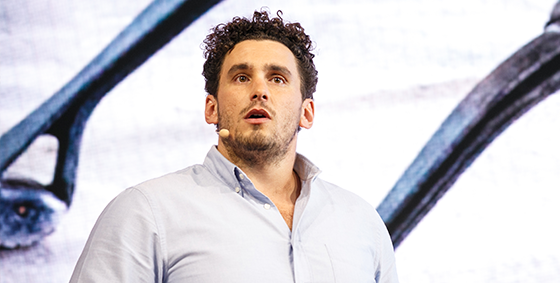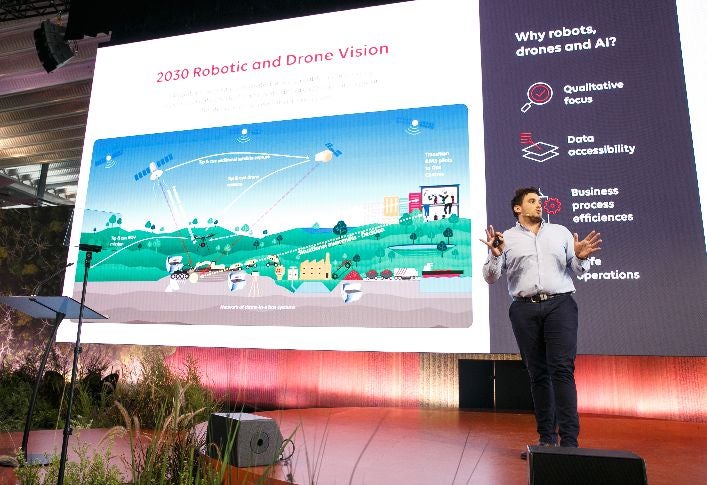Posted by on
11/05/2023
Paris Cockinos’ predictions for Australian agriculture are exciting and visionary, with the potential of drone technology to significantly reduce physical workloads and farm labour shortages.
The CEO of Sphere Drones, a company that specialises in leveraging the power of drones to transform traditional farming practices, Paris recently presented at Rabobank’s Farm2Fork Summit, outlining some of the company’s practical solutions and vision for the future.
“Farm2Fork was a valuable opportunity to hear first-hand from farmers about their pain points, and it was also to an opportunity for us to challenge farmers thoughts and probe their thinking, the technology is here, it’s developing every day and the potential for agriculture is enormous,” Paris said.
Explaining that automated aerial observation via drones will ease physical workloads significantly, Paris outlined how mundane paddock tasks can be outsourced through drone technology.
“There’s a wish list of things farmers want to unlock – from calving observation, managing and checking livestock, making sure your fencing, troughs, hay feeders all well looked after – we’re able to design a drone to think like a farmer and carry out these tasks autonomously, flagging any issues immediately.”
Automated monitoring of pre-surveyed fences and paddocks, and e-tagged cattle for any calving or nutritional red flags will all be at a farmer’s fingertip without leaving home.
“We can train a drone to identify if a fence is down or if there are pigs in a trough, and estimate that – for a farmer travelling about 500km a week chasing fence lines and monitoring paddocks - this will save 78 days a year.”
“The impact of that will be huge on ag, it means you can remove the person completely, and provides the opportunity to save a farmer, who has a really unique skillset, time.”
Paris admits that chasing the concept of augmenting the observation of how a farmer operates their day to day tasks had become “thorn in his backside”.
“It’s a substantial cultural shift and I find that really exciting because it’s a bit of a challenge for our organisation to demonstrate how these technologies can change so much.”
A game changer in aerial application
There are opportunities “left, right and centre” within the spraying and seeding space, Paris said, with enormous potential for drones to conduct aerial application.
“Farmers traditionally use fixed wing ‘crop dusters’ at quite a large expense, so we have a willing and engaged natural audience looking for this solution.”

While challenges remain, specifically surrounding a drone’s holding capacity and power, he said the technological advancements were game changing.
In 2014 drones flew for five minutes, currently flying for 45 minutes and by 2030, he predicts they’ll be flying for five hours at a time.
“Considering this advancement, and the fact that in Australia the agricultural land mass is 55 per cent, there’s a lot of land to cover and we think drones are an affordable and practical solution.”
Travelling for a long time is one thing, yet managing and balancing a sufficient load was the second challenge.
“A fixed wing crop duster can hold roughly 1,800 litres, whereby a drone can hold 40 litres,” he explained. “Yet considering just last year, a drone could only hold five litres, the progress is staggering, and will only get bigger and better.”
“The other fascinating potential is in regards to aerial weed control – why do you need to dust at scale if you’ve got isolated issues?”
Drones are capable of identifying weeds, and, as he explained, proactively and almost in a cognitive state, will be able to spot spray that location, reducing overall costs, and load requirements.
Sphere Drones currently has four drones being used as an alternative to fixed wing application on a property in the Coonamble region, with the technology continually evolving.

“While drones hold only a fraction compare to a crop duster, at about two per cent of a crop dusters capacity, I’m confident we’ll get to 30 per cent of a crop duster’s capacity in the next five years.”
The introduction of AI into the system advances the capacity of drones significantly, with the technology progressively improving in time as the AI learns.
From plant health mapping and pest detection to cattle head counts and perimeter surveys, drones leveraging AI are providing invaluable data and insights that are helping farmers make informed decisions and optimise their operations.
“The potential for fully integrated AI ‘Smart Farms’ means we’ll have more data than ever in regards to know how land works and responds, making farms more intelligent through drone observations over many years, which is a very exciting prospect.”
